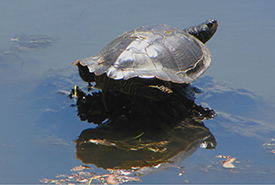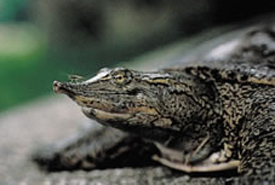Diving into winter hibernation

Northern map turtle (Photo by D. Gordon and E. Robertson)
It’s official: winter has made its way across Canada, and isn’t going anywhere anytime soon.
Humans layer up to brave the cold, and migratory birds make their way to warmer climates, but turtles have their own way of toughing out the cold, Canadian winters.
They go into brumation — a state similar to true hibernation. Turtles are ectothermic (cold-blooded) animals and can’t control their body temperature like birds and mammals can. Instead, they absorb body heat from their surrounding environments.
In late fall, freshwater turtles in Canada begin to brumate. As their core body temperature lowers, so does their metabolism. The colder the turtle gets, the slower its metabolism becomes. Turtles are dependent on stored energy and oxygen in the water to support their minimal needs to survive the winter. Some are able to breathe underwater or in mud, through cloacal respiration (through their butts).
Turtles cannot survive freezing. Freshwater turtles hibernate in water, as their body temperatures remain relatively stable throughout the winter and will not dip below 0 C. As it takes a lot of energy for water temperatures to change, most pond and lake bottoms don’t freeze and stay around the same temperature through the colder months.
As ice sheets develop over the surface of freshwater bodies in winter, oxygen in the water becomes limited. This oxygen is used up by turtles and other aquatic species, and the water becomes hypoxic (low in oxygen) or anoxic (no oxygen available). Some turtle species can tolerate this flux of oxygen content, while others cannot and will die.
When a pond or lake becomes hypoxic or anoxic, species such as snapping turtles and painted turtles change the way they use their metabolism for a short period of time. This extraordinary method of survival involves the turtle burning the calcium from their shell and skeleton to neutralize the lactic acid building up in their bodies from the lack of oxygen. When these turtles come out of hibernation, their bodies are often cramped up from the acid build-up. To counteract this, they bask in the sun to increase their body temperature. As their body temperature increases, their metabolism starts to kick in to break down the acidic by-products stored in their muscles. During this time, though, they move even more slowly than usual, making them more susceptible to predators.
It is important to keep all habitats for turtle species safe. In addition to sites for brumation, turtles need safe places in which to feed, bask and nest. Habitat loss and fragmentation have impacted turtles across Canada, and all turtle species are now at risk or have a population/subspecies at risk.

Spiny softshell turtle (Photo by NCC)
The Nature Conservancy of Canada (NCC) has protected habitat for eight of Canada’s freshwater turtle species. For example, NCC is actively involved in a number of initiatives to protect the threatened spiny softshell turtle, including habitat protection, stewardship and the restoration of protected areas in and around Champlain Lake. NCC is also a member of the Spiny Softshell Recovery Team. The team coordinates volunteers from SOS Turtles, which is involved in turtle spawning site cleanups, nest monitoring and eggshell collection each fall (this information is used to survey the number of turtles born at each nest site).
NCC has also been working to protect and restore wood turtle habitat in Ontario.
In addition, NCC launched the Carapace Project to report sightings of turtles on roads and/or in their natural habitat year-round. The goal of this project is to develop a map that will help give a better idea of where to focus protection efforts for each turtle species and increase their survival rates every season.


